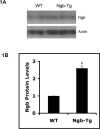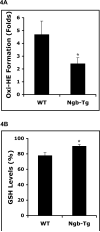Effects of neuroglobin overexpression on mitochondrial function and oxidative stress following hypoxia/reoxygenation in cultured neurons
- PMID: 18711728
- PMCID: PMC2631383
- DOI: 10.1002/jnr.21826
Effects of neuroglobin overexpression on mitochondrial function and oxidative stress following hypoxia/reoxygenation in cultured neurons
Abstract
Neuroglobin (Ngb) is a recently discovered tissue globin with a high affinity for oxygen that is widely and specifically expressed in neurons of vertebrate central and peripheral nervous systems. Our laboratory and others have shown Ngb overexpression can protect neurons against hypoxic/ischemic insults, but the underlying mechanisms remain poorly understood. In this study, we examined the effects of Ngb overexpression on mitochondrial function, oxidative stress, and neurotoxicity in primary cortical neurons following hypoxia/reoxygenation (H/R). Ngb-overexpressing transgenic neurons (Ngb-Tg) were significantly protected against H/R-induced cell death. Rates of decline in ATP levels, MTT reduction, and mitochondrial membrane potential were significantly ameliorated in Ngb-Tg neurons. Furthermore, Ngb overexpression reduced superoxide anion generation after H/R, whereas glutathione levels were significantly improved compared with WT controls. Taken together, these data suggest that Ngb is neuroprotective against hypoxia, in part by improving mitochondria function and decreasing oxidative stress.
2008 Wiley-Liss, Inc.
Figures






References
-
- Awenius C, Hankeln T, Burmester T. Neuroglobins from the zebrafish Danio rerio and the pufferfish Tetraodon nigroviridis. Biochem Biophys Res Commun. 2001;287(2):418–421. - PubMed
-
- Bentmann A, Schmidt M, Reuss S, Wolfrum U, Hankeln T, Burmester T. Divergent distribution in vascular and avascular mammalian retinae links neuroglobin to cellular respiration. J Biol Chem. 2005;280(21):20660–20665. - PubMed
-
- Bunn HF, Poyton RO. Oxygen sensing and molecular adaptation to hypoxia. Physiol Rev. 1996;76(3):839–885. - PubMed
Publication types
MeSH terms
Substances
Grants and funding
LinkOut - more resources
Full Text Sources
Other Literature Sources
Miscellaneous

